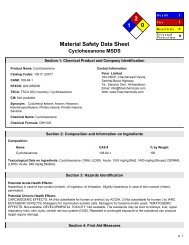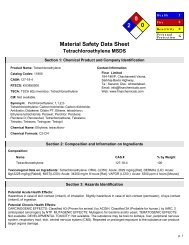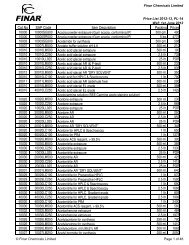Create successful ePaper yourself
Turn your PDF publications into a flip-book with our unique Google optimized e-Paper software.
Product Name: Sodium bromide<br />
Catalog Codes: 11555<br />
CAS#: 7647-15-6<br />
RTECS: VZ3150000<br />
TSCA: TSCA 8(b) inventory: Sodium bromide<br />
CI#: Not available.<br />
Synonym: Bromide salt of sodium<br />
Chemical Name: Sodium Bromide<br />
Chemical Formula: NaBr<br />
Composition:<br />
Material Safety Data Sheet<br />
Sodium bromide <strong>MSDS</strong><br />
Section 1: Chemical Product and Company Identification<br />
Contact Information:<br />
2<br />
0<br />
0<br />
<strong>Finar</strong> <strong>Limited</strong><br />
184-186/P, Chacharwadi Vasna,<br />
Sarkhej-Bavla Highway,<br />
Ta.: Sanand, Dist.: Ahmedabad,<br />
Email: info@finarchemicals.com<br />
Web: www.finarchemicals.com<br />
Section 2: Composition and Information on Ingredients<br />
Name CAS # % by Weight<br />
Sodium bromide 7647-15-6 100<br />
He a lt h<br />
Fire<br />
Re a c t iv it y<br />
Pe rs o n a l<br />
Pro t e c t io n<br />
Toxicological Data on Ingredients: Sodium bromide: ORAL (LD50): Acute: 3500 mg/kg [Rat]. 7000 mg/kg [Mouse].<br />
Section 3: Hazards Identification<br />
Potential Acute Health Effects:<br />
Hazardous in case of eye contact (irritant), of ingestion, of inhalation. Slightly hazardous in case of skin contact (irritant).<br />
Potential Chronic Health Effects:<br />
CARCINOGENIC EFFECTS: Not available. MUTAGENIC EFFECTS: Not available. TERATOGENIC EFFECTS: Not available.<br />
DEVELOPMENTAL TOXICITY: Not available. Repeated or prolonged exposure is not known to aggravate medical condition.<br />
Section 4: First Aid Measures<br />
Eye Contact:<br />
Check for and remove any contact lenses. In case of contact, immediately flush eyes with plenty of water for at least 15<br />
minutes. Cold water may be used. Get medical attention.<br />
Skin Contact:<br />
2<br />
0<br />
0<br />
E<br />
p. 1
Wash with soap and water. Cover the irritated skin with an emollient. Get medical attention if irritation develops. Cold water<br />
may be used.<br />
Serious Skin Contact: Not available.<br />
Inhalation:<br />
If inhaled, remove to fresh air. If not breathing, give artificial respiration. If breathing is difficult, give oxygen. Get medical<br />
attention.<br />
Serious Inhalation: Not available.<br />
Ingestion:<br />
Do NOT induce vomiting unless directed to do so by medical personnel. Never give anything by mouth to an unconscious<br />
person. Loosen tight clothing such as a collar, tie, belt or waistband. Get medical attention if symptoms appear.<br />
Serious Ingestion: Not available.<br />
Flammability of the Product: Non-flammable.<br />
Auto-Ignition Temperature: Not applicable.<br />
Flash Points: Not applicable.<br />
Flammable Limits: Not applicable.<br />
Products of Combustion: Not available.<br />
Section 5: Fire and Explosion Data<br />
Fire Hazards in Presence of Various Substances: Not applicable.<br />
Explosion Hazards in Presence of Various Substances:<br />
Risks of explosion of the product in presence of mechanical impact: Not available. Risks of explosion of the product in<br />
presence of static discharge: Not available.<br />
Fire Fighting Media and Instructions: Not applicable.<br />
Special Remarks on Fire Hazards: Not available.<br />
Special Remarks on Explosion Hazards: Not available.<br />
Section 6: Accidental Release Measures<br />
Small Spill:<br />
Use appropriate tools to put the spilled solid in a convenient waste disposal container. Finish cleaning by spreading water on<br />
the contaminated surface and dispose of according to local and regional authority requirements.<br />
Large Spill:<br />
Use a shovel to put the material into a convenient waste disposal container. Finish cleaning by spreading water on the<br />
contaminated surface and allow to evacuate through the sanitary system.<br />
Section 7: Handling and Storage<br />
Precautions:<br />
Do not ingest. Do not breathe dust. Avoid contact with eyes. Wear suitable protective clothing. In case of insufficient<br />
ventilation, wear suitable respiratory equipment. If ingested, seek medical advice immediately and show the container or the<br />
label. Keep away from incompatibles such as oxidizing agents, acids.<br />
Storage: Keep container tightly closed. Keep container in a cool, well-ventilated area. Do not store above 25°C (77°F).<br />
Section 8: Exposure Controls/Personal Protection<br />
p. 2
Engineering Controls:<br />
Use process enclosures, local exhaust ventilation, or other engineering controls to keep airborne levels below recommended<br />
exposure limits. If user operations generate dust, fume or mist, use ventilation to keep exposure to airborne contaminants<br />
below the exposure limit.<br />
Personal Protection:<br />
Splash goggles. Lab coat. Dust respirator. Be sure to use an approved/certified respirator or equivalent. Gloves.<br />
Personal Protection in Case of a Large Spill:<br />
Splash goggles. Full suit. Dust respirator. Boots. Gloves. A self contained breathing apparatus should be used to avoid<br />
inhalation of the product. Suggested protective clothing might not be sufficient; consult a specialist BEFORE handling this<br />
product.<br />
Exposure Limits: Not available.<br />
Physical state and appearance: Solid.<br />
Odor: Not available.<br />
Taste: Not available.<br />
Molecular Weight: 102.91 g/mole<br />
Color: Not available.<br />
pH (1% soln/water): 6.5-8.0<br />
Boiling Point: 1390°C (2534°F)<br />
Melting Point: 755°C (1391°F)<br />
Critical Temperature: Not available.<br />
Specific Gravity: 3.21 (Water = 1)<br />
Vapor Pressure: Not applicable.<br />
Vapor Density: Not available.<br />
Volatility: Not available.<br />
Odor Threshold: Not available.<br />
Water/Oil Dist. Coeff.: Not available.<br />
Ionicity (in Water): Not available.<br />
Dispersion Properties: See solubility in water, methanol.<br />
Section 9: Physical and Chemical Properties<br />
Solubility:<br />
Easily soluble in cold water, hot water. Soluble in methanol. 1 g dissolves in 1.1 ml of water. 1 g dissolves in about 16 ml of<br />
alcohol. 1 g dissolves in 6 ml of methanol<br />
Stability: The product is stable.<br />
Instability Temperature: Not available.<br />
Conditions of Instability: Incompatible materials, moisture<br />
Section 10: Stability and Reactivity Data<br />
Incompatibility with various substances: Reactive with oxidizing agents, acids.<br />
p. 3
Corrosivity: Non-corrosive in presence of glass.<br />
Special Remarks on Reactivity:<br />
Absorbs moisture from the air but is not deliquescent. Hygroscopic. Also incompatible with alkaloidal and heavy metal salts,<br />
and Bromine Trifluoride.<br />
Special Remarks on Corrosivity: Not available.<br />
Polymerization: Will not occur.<br />
Routes of Entry: Inhalation. Ingestion.<br />
Section 11: Toxicological Information<br />
Toxicity to Animals: Acute oral toxicity (LD50): 3500 mg/kg [Rat].<br />
Chronic Effects on Humans: Not available.<br />
Other Toxic Effects on Humans:<br />
Hazardous in case of ingestion, of inhalation. Slightly hazardous in case of skin contact (irritant).<br />
Special Remarks on Toxicity to Animals: Not available.<br />
Special Remarks on Chronic Effects on Humans:<br />
May cause adverse reproductive effects (male and female effects on fertility and effects on newborns and fetotoxicity) based<br />
on animal data Human: passes the placental barrier, detected in maternal milk.<br />
Special Remarks on other Toxic Effects on Humans:<br />
Acute Potential Health Effects: Skin: May cause mild skin irritation. Eyes: Causes eye irritation. Inhalation: May cause<br />
respiratory tract irritation. Ingestion: May cause gastrointestinal tract irritation with nausea and vomiting, abdominal pain,<br />
constipation. Bromide poisoning following acute ingestion is more rare and may affect the central nervous system (CNS<br />
depression - somnolence, confusion, ataxia, coma and other symptoms similar to chronic ingestion), cardiovascular system<br />
(hypotension, tachycardia), kidneys (acute renal failure, urinary incontinence), and respiration (acute respiratory distress<br />
syndrome). It may also cause eye disturbances such as mydriasis and nystagmus, disturbances of apparent color of objects,<br />
blurring or indistinctness of vision, apparent movement or wiggling and change in apparent size of objects, large pupils,<br />
subnormal reaction to light, diplopia, and photophobia. Chronic Potential Health Effects: Skin: Prolonged or repeated skin<br />
contact may cause skin rashes. Eyes: Prolonged or repeated eye contact may cause blepharitis, and conjunctivitis. Prolonged<br />
or repeated ingestion may cause skin rashes (bromoderma, acne, pyoderma gangrenosum, erythema multiforme), affect the<br />
liver, endocrine system (thyroid), metabolism(anorexia), blood, vision (visual disturbances, permanently decreased vision<br />
and may produce a toxic syndrome, "Bromism" which may be characterized by behavior/central nervous symptoms such<br />
CNS depression, irritability, headache, confusion, slurred speech, memory loss, lethargy, ataxia, tremor, agitation, delusion,<br />
disoriented, paranoia, aggressiveness, hallucinations, mania, fatigue, seizure, neuropathy, muscle weakness, coma. Also, in<br />
individuals with chronic bromism, the tongue may have a coated or furred appearance.<br />
Ecotoxicity: Not available.<br />
BOD5 and COD: Not available.<br />
Section 12: Ecological Information<br />
Products of Biodegradation:<br />
Possibly hazardous short term degradation products are not likely. However, long term degradation products may arise.<br />
Toxicity of the Products of Biodegradation: The product itself and its products of degradation are not toxic.<br />
Special Remarks on the Products of Biodegradation: Not available.<br />
Waste Disposal:<br />
Section 13: Disposal Considerations<br />
p. 4
Waste must be disposed of in accordance with federal, state and local environmental control regulations.<br />
Section 14: Transport Information<br />
DOT Classification: Not a DOT controlled material (United States).<br />
Identification: Not applicable.<br />
Special Provisions for Transport: Not applicable.<br />
Section 15: Other Regulatory Information<br />
Federal and State Regulations: TSCA 8(b) inventory: Sodium bromide<br />
Other Regulations: EINECS: This product is on the European Inventory of Existing Commercial Chemical Substances.<br />
Other Classifications:<br />
WHMIS (Canada): Not controlled under WHMIS (Canada).<br />
DSCL (EEC):<br />
R36- Irritating to eyes. S2- Keep out of the reach of children. S24/25- Avoid contact with skin and eyes. S46- If swallowed,<br />
seek medical advice immediately and show this container or label.<br />
HMIS (U.S.A.):<br />
Health Hazard: 2<br />
Fire Hazard: 0<br />
Reactivity: 0<br />
Personal Protection: E<br />
National Fire Protection Association (U.S.A.):<br />
Health: 2<br />
Flammability: 0<br />
Reactivity: 0<br />
Specific hazard:<br />
Protective Equipment:<br />
Gloves. Lab coat. Dust respirator. Be sure to use an approved/certified respirator or equivalent. Splash goggles.<br />
References: Not available.<br />
Other Special Considerations: Not available.<br />
Created: 10/06/2010<br />
Last Updated: 29/11/2012<br />
Section 16: Other Information<br />
The information above is believed to be accurate and represents the best information currently available to us. However, we<br />
make no warranty of merchantability or any other warranty, express or implied, with respect to such information, and we assume<br />
no liability resulting from its use. Users should make their own investigations to determine the suitability of the information for<br />
their particular purposes. In no event shall <strong>Finar</strong> <strong>Chemicals</strong> <strong>Limited</strong> be liable for any claims, losses, or damages of any third<br />
party or for lost profits or any special, indirect, incidental, consequential or exemplary damages, howsoever arising, even if<br />
<strong>Finar</strong> <strong>Limited</strong> has been advised of the possibility of such damages.<br />
p. 5







